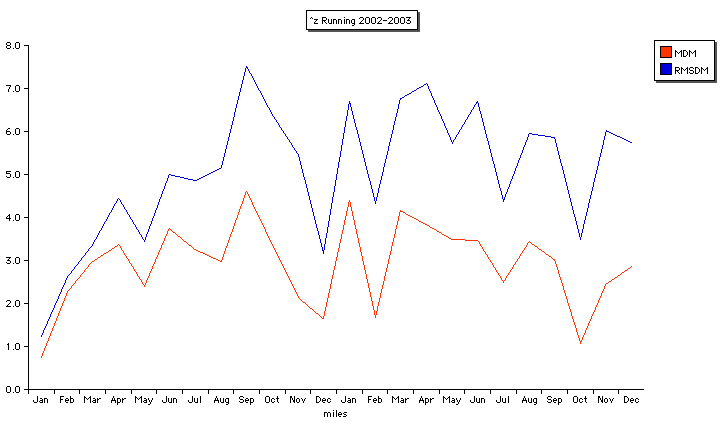How to quantify exercise? The most common numerical measurement for runners is simple mileage, averaged perhaps over a week or a month. That obviously ignores a host of significant factors: speed, hills, temperature, humidity, altitude, etc. It also leaves out the constellation of personal parameters: age, sex, weight, illness, and so on.
But nevertheless average mileage is a popular metric, for good reason. It offers a straightforward and decently objective first-order way to characterize a training program. But what's the next step? My modest suggestion: RMSDM = Root Mean Square Daily Miles (or any other distance measure that you prefer).
"Root Mean Square" is a simple mathematical process. An ordinary "Mean" is an average; to do a Root Mean Square just square each of the numbers before you average them, and then take the square root of the result. That process emphasizes the largest of the input values — precisely what a good distance-running metric should do. (Long runs are crucial to the development of endurance.) The RMS value equals the simple average only when all data points are equal. Otherwise, RMS is always a larger number. (Makes for better boasting rights, eh?!)
Consider a specific low-mileage example. Someone who does precisely 3 miles every day has a mean daily mileage (MDM) of 3, the same as the RMSDM value. (Pretty dull as a regime, and not likely to be either fun or effective.) But skip the junk miles on Monday, Wednesday, and Friday, jog 10 on Saturday, then take Sunday off to recover — and the result is an RMSDM of 4.1 — a 37% increase over the flat-rate training program yet with 24% fewer average miles!
Take a look at the ^z personal logbooks for 2002 and 2003. In the first year I covered 1015 miles in training and races, giving a mean daily result of 2.8 miles, slightly under 20 miles/week. My RMS daily mileage was 4.7, reflecting a preponderance of short jogs around the neighborhood. In 2003 I managed 1110 miles, for a MDM of 3.0, less than 10% greater than the previous year — but my RMSDM increased a dramatic 23% to 5.8 miles.
Here's a quick graph of that record:

This shows the power of the long run on the root mean square — similar to the long run's power to improve stamina. (I can hardly wait to see this year's data; with the 50 kilometer HAT Run 2004 to pump up that RMSDM I don't need no stinkin' steroids!)
(see also NeedForSpeed (10 Aug 2002), LogbookTyrannicide (17 Oct 2002), HandicapJogging (8 Oct 2003), TwoYearsLater (6 Feb 2004), ...)
TopicRunning - TopicScience - TopicPersonalHistory - TopicHumor - 2004-04-24
(correlates: FourTypes, SheepMaySafelyGraze, SpeedUpSlowDown, ...)